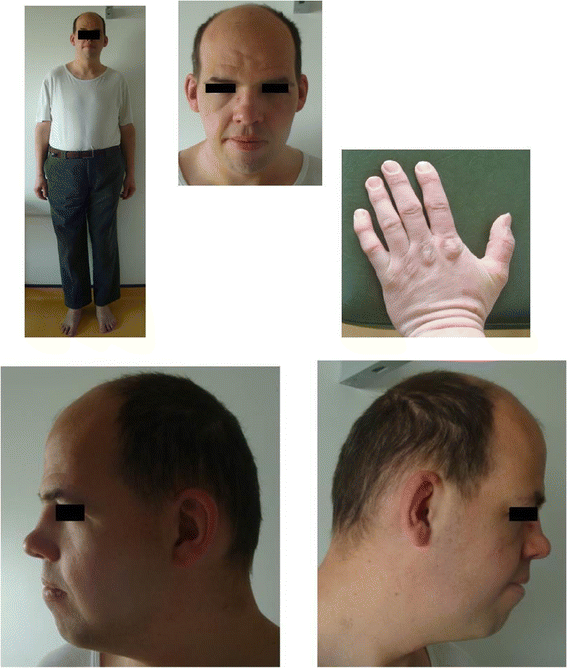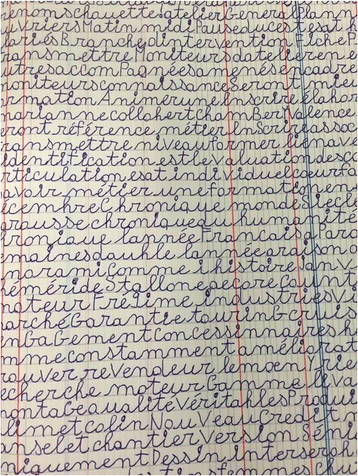Autism spectrum disorder associated with 49,XYYYY: case report and review of the literature
- PMID: 28137251
- PMCID: PMC5282903
- DOI: 10.1186/s12881-017-0371-1
Autism spectrum disorder associated with 49,XYYYY: case report and review of the literature
Abstract
Background: Sex chromosome aneuploidies occur in approximately one in 420 live births. The most frequent abnormalities are 45,X (Turner syndrome), 47,XXX (triple X), 47,XXY (Klinefelter syndrome), and 47,XYY. The prevalence of males with more than one extra sex chromosome (e.g. 48,XXYY or 48,XXXY) is less common. However, the literature provides little information about the cognitive and behavioural phenotype and the natural history of the disease. We report the clinical, neurocognitive, social cognitive and psychiatric characterization of a patient with 49,XYYYY syndrome.
Case presentation: The patient presented with a complex phenotype including a particular cognitive profile with intellectual deficiency and autism spectrum disorder (ASD) with limited interests. Moreover, social anxiety disorder with selective mutism and separation anxiety disorder were observed (DSM-5 criteria, MINI Assessment).
Conclusion: It is now admitted that 49,XYYYY has unique medical, neurodevelopmental and behavioural characteristics. Interestingly, ASD is more common in groups with Y chromosome aneuploidy. This clinical report suggests that understanding the cognitive and social functioning of these patients may provide new insights into possible therapeutic strategies, as cognitive remediation or social cognitive training.
Keywords: Autism spectrum disorder; Behavioural disorders; Neurocognition; Social cognition; XYYYY.
Figures
Similar articles
-
Autism Spectrum Disorder in Males with Sex Chromosome Aneuploidy: XXY/Klinefelter Syndrome, XYY, and XXYY.J Dev Behav Pediatr. 2017 Apr;38(3):197-207. doi: 10.1097/DBP.0000000000000429. J Dev Behav Pediatr. 2017. PMID: 28333849 Free PMC article.
-
Clinical, Cognitive and Neurodevelopmental Profile in Tetrasomies and Pentasomies: A Systematic Review.Children (Basel). 2022 Nov 9;9(11):1719. doi: 10.3390/children9111719. Children (Basel). 2022. PMID: 36360447 Free PMC article. Review.
-
Sex chromosome tetrasomy and pentasomy.Pediatrics. 1995 Oct;96(4 Pt 1):672-82. Pediatrics. 1995. PMID: 7567329 Review.
-
Sex differences in psychiatric disorders: what we can learn from sex chromosome aneuploidies.Neuropsychopharmacology. 2019 Jan;44(1):9-21. doi: 10.1038/s41386-018-0153-2. Epub 2018 Jul 16. Neuropsychopharmacology. 2019. PMID: 30127341 Free PMC article. Review.
-
Neurocognitive variance and neurological underpinnings of the X and Y chromosomal variations.Am J Med Genet C Semin Med Genet. 2013 Feb 15;163C(1):35-43. doi: 10.1002/ajmg.c.31352. Epub 2013 Jan 18. Am J Med Genet C Semin Med Genet. 2013. PMID: 23335129 Review.
Cited by
-
Reproductive outcomes of 3 infertile males with XYY syndrome: Retrospective case series and literature review.Medicine (Baltimore). 2020 Feb;99(9):e19375. doi: 10.1097/MD.0000000000019375. Medicine (Baltimore). 2020. PMID: 32118782 Free PMC article. Review.
-
Behavioral and cellular responses to circadian disruption and prenatal immune activation in mice.Sci Rep. 2023 May 13;13(1):7791. doi: 10.1038/s41598-023-34363-w. Sci Rep. 2023. PMID: 37179433 Free PMC article.
-
Profiling of Sexually Dimorphic Genes in Neural Cells to Identify Eif2s3y, Whose Overexpression Causes Autism-Like Behaviors in Male Mice.Front Cell Dev Biol. 2021 Jul 6;9:669798. doi: 10.3389/fcell.2021.669798. eCollection 2021. Front Cell Dev Biol. 2021. PMID: 34307355 Free PMC article.
-
Pseudoautosomal Region 1 Overdosage Affects the Global Transcriptome in iPSCs From Patients With Klinefelter Syndrome and High-Grade X Chromosome Aneuploidies.Front Cell Dev Biol. 2022 Feb 3;9:801597. doi: 10.3389/fcell.2021.801597. eCollection 2021. Front Cell Dev Biol. 2022. PMID: 35186953 Free PMC article.
-
Rare 48, XYYY syndrome: case report and review of the literature.Clin Case Rep. 2017 Dec 7;6(1):179-184. doi: 10.1002/ccr3.1311. eCollection 2018 Jan. Clin Case Rep. 2017. PMID: 29375860 Free PMC article.
References
-
- Linden MG, Bender BG, Robinson A. Sex chromosome tetrasomy and pentasomy. Pediatrics. 1995;96:672–688. - PubMed
-
- Wechsler D. Picture completion subtest In WAIS-III. San Antonio: The Psychological Corporation; 1997.
Publication types
MeSH terms
LinkOut - more resources
Full Text Sources
Other Literature Sources
Medical
Molecular Biology Databases



